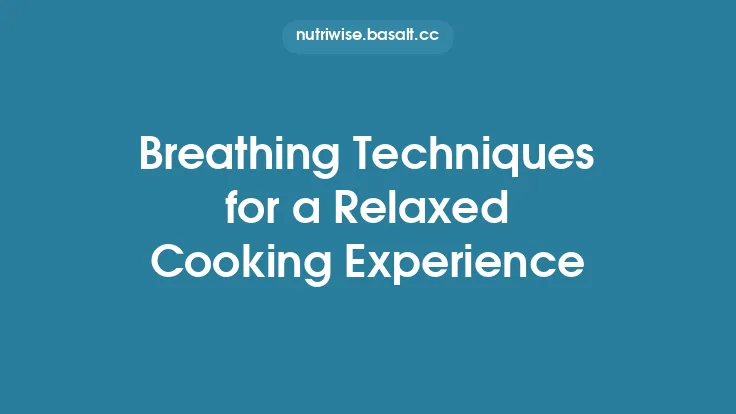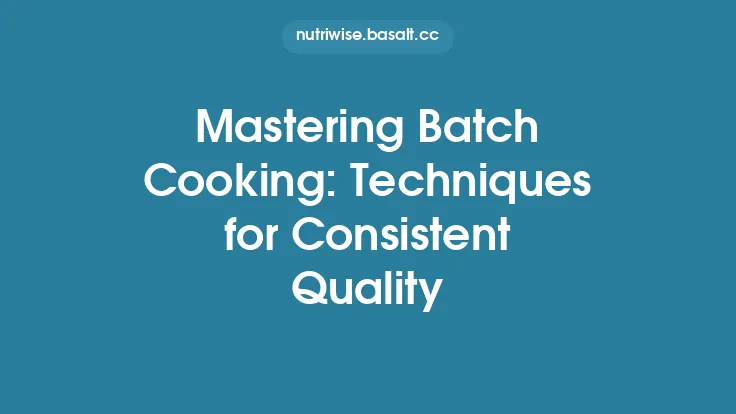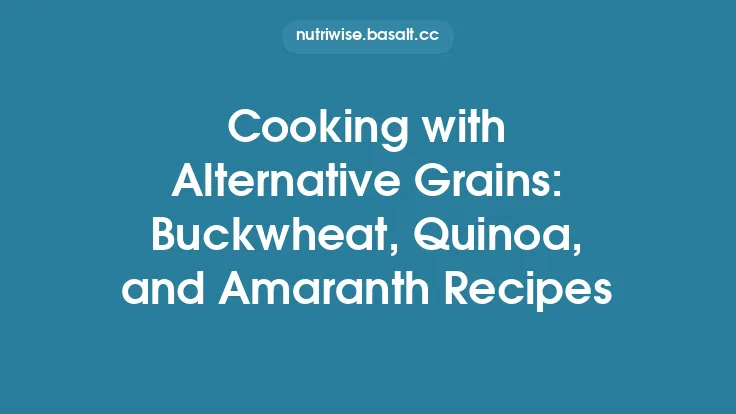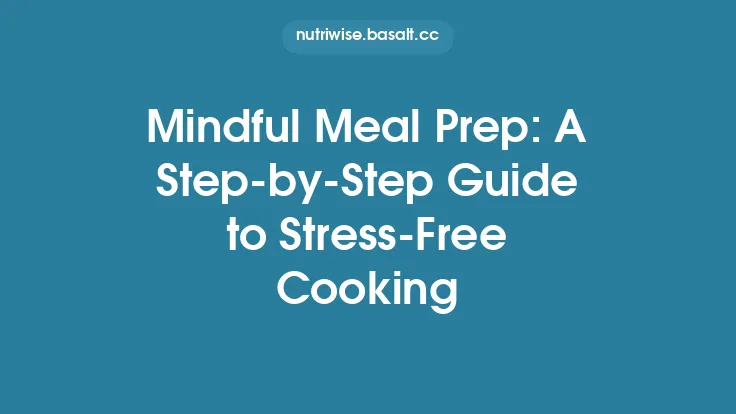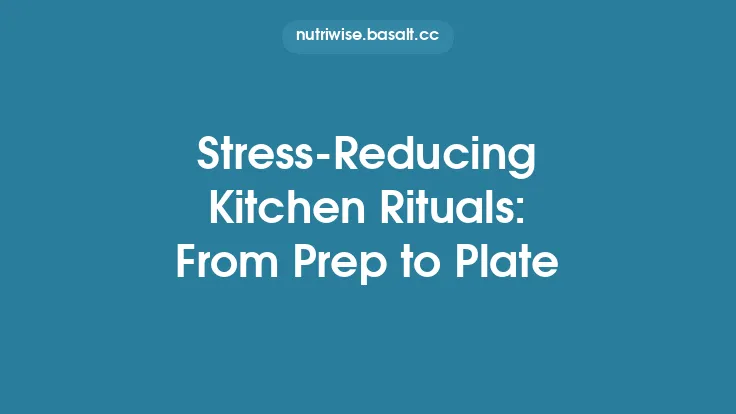Cooking can feel like a high‑stakes performance, especially when the clock is ticking, the pantry is a maze, and the expectation of a perfect plate looms large. The resulting anxiety often turns the kitchen from a place of creativity into a source of stress. Yet the very act of preparing food offers a natural avenue for calm—if we approach it with intention. By deliberately shaping our mindset, workflow, and environment, we can transform cooking into a steady, purposeful practice that eases tension rather than amplifies it.
Defining Intentional Cooking
Intentional cooking is more than simply following a recipe; it is a conscious decision to align each step with a clear purpose. This purpose can be as specific as “serve a nourishing dinner for my family without feeling rushed” or as broad as “use this meal as a moment to practice focused attention.” The key distinction lies in why we do each action, not just what we do. When the purpose is explicit, the kitchen becomes a stage for purposeful activity rather than a battlefield of competing demands.
Preparing the Mental Landscape
- Set an Intention Statement
Before you even open the fridge, articulate a brief statement that captures the desired quality of the cooking experience. For example: “I will move through each step calmly, allowing the aromas to guide me without judgment.” Write it on a sticky note or say it aloud; the act of verbalizing anchors the mind.
- Mental Rehearsal
Spend a minute visualizing the flow of the meal—from gathering ingredients to plating. Mentally walk through each transition (e.g., “I will chop the vegetables, then immediately rinse the cutting board”). This rehearsal reduces surprise and creates a mental script that the brain can follow with less effort.
- Positive Self‑Talk
Replace automatic critiques (“I’m terrible at timing”) with constructive cues (“I’m learning to gauge heat by feel”). Reframing thoughts in real time curtails the spiral of self‑doubt that fuels anxiety.
Reducing Cognitive Load Through Structured Planning
Cooking involves juggling multiple variables: ingredients, timing, temperature, and technique. Overloading working memory is a primary source of kitchen stress. Structured planning offloads that burden.
- Ingredient Mapping
List every component of the recipe, then group items by location (e.g., pantry, fridge, freezer). This prevents frantic back‑and‑forth trips.
- Step Sequencing Chart
Break the recipe into discrete actions and assign a rough duration to each. Arrange them in the order they will be performed, noting any steps that can run concurrently (e.g., “while the sauce simmers, preheat the oven”).
- Checklists
Use a simple checklist for prep tasks (wash, peel, measure). Checking off items provides visual confirmation of progress and reduces the mental effort of remembering what’s been done.
- Digital Aids
Apps that convert recipes into step‑by‑step timers or that generate shopping lists from recipes can further lighten the mental load.
Optimizing Physical Workflow
A well‑organized physical space translates directly into mental ease.
- Station Setup
Designate a “prep zone” for chopping, a “cooking zone” for pots and pans, and a “clean‑up zone” for waste. Keep the tools you’ll need for each zone within arm’s reach; this minimizes unnecessary movement.
- Equipment Readiness
Before you start, ensure all required cookware, utensils, and appliances are clean and functional. Pre‑heat ovens or pans as needed, and have measuring cups, spoons, and a timer at hand.
- Parallel Processing
Identify tasks that can safely overlap. For instance, while water comes to a boil, you can dice vegetables. Use visual cues (e.g., a pot on the stove with a timer set) to keep track of simultaneous processes.
- Smart Devices
Bluetooth thermometers, programmable slow‑cookers (used for convenience rather than the slow‑cooking philosophy), and voice‑activated timers free you from constantly checking temperatures and times.
Managing Time and Pace
Time pressure is a common anxiety trigger. Managing it deliberately can restore a sense of control.
- Time Buffers
Add a 5‑minute cushion to each major step. If a sauce is supposed to simmer for 20 minutes, set the timer for 25. The extra minutes absorb minor delays without derailing the overall schedule.
- Pacing Anchors
Choose a rhythmic cue—such as a song’s tempo or a metronome set to 60 beats per minute—to guide the speed of repetitive actions like stirring or chopping. A steady pace prevents frantic acceleration when the clock seems to be ticking.
- Pause Points
Insert brief, intentional pauses after completing a cluster of tasks (e.g., after chopping all vegetables). Use this moment to assess the workspace, wipe down surfaces, and reset focus before moving on.
Leveraging the Senses for Efficiency, Not Distraction
While sensory awareness is a separate discipline, using the senses pragmatically can streamline cooking without turning it into a meditative exercise.
- Visual Checks
Glance at the color change in sautéed onions to gauge doneness rather than relying solely on timers.
- Auditory Cues
Listen for the sizzle of a hot pan to confirm the correct temperature before adding ingredients.
- Tactile Feedback
Feel the firmness of a cooked vegetable to determine if it’s al dente, reducing the need for repeated tasting.
These functional sensory inputs keep the process moving smoothly, minimizing the mental effort of constant monitoring.
Incorporating External Aids
The kitchen environment can be subtly tuned to support a calm workflow.
- Music Playlists
Curate playlists with a consistent tempo (around 70–80 BPM) to set a relaxed rhythm. Instrumental tracks reduce lyrical distraction while still providing a pleasant backdrop.
- Ambient Sound
Low‑level white noise or nature sounds can mask sudden kitchen noises (e.g., a timer beeping) that might startle you.
- Lighting
Bright, even lighting on the prep area reduces eye strain and the need to squint, which can cause tension headaches.
- Temperature Control
A comfortably cool kitchen (around 68–70°F) prevents overheating, which can exacerbate irritability and fatigue.
Building Resilience Through Incremental Skill Development
Anxiety often stems from a fear of failure. Tackling cooking skill by skill builds confidence.
- Select a Single Technique
Focus on mastering one method—such as perfecting a roux or achieving a consistent sear—before expanding to more complex dishes.
- Deliberate Practice
Repeat the technique in multiple recipes, noting subtle adjustments each time. Document observations in a cooking journal.
- Growth Mindset
Treat mistakes as data points. If a sauce separates, record the temperature and timing, then adjust in the next attempt.
- Celebrate Small Wins
Acknowledge progress (“I kept the sauce smooth for the first time”) to reinforce positive associations with cooking.
Post‑Cooking Review and Adjustment
The end of a meal is an ideal moment for a brief, structured debrief.
- Quick Log
Jot down three items: what went smoothly, what caused a hiccup, and one adjustment for next time.
- Intention Check
Reflect on whether the original intention was met. If not, identify the specific barrier (e.g., “I skipped the pause point and felt rushed”).
- Plan for Improvement
Translate the insight into a concrete change for the next cooking session—perhaps adding a 2‑minute buffer before plating or pre‑measuring spices the night before.
Regular reviews create a feedback loop that gradually reduces anxiety by turning each cooking experience into a learning cycle.
Bringing It All Together
Cooking with intention is a systematic approach that aligns mindset, planning, workflow, and environment to diminish kitchen anxiety. By setting clear purpose statements, offloading mental tasks onto structured plans, optimizing the physical space, and using subtle sensory and environmental cues, the act of preparing food becomes a controlled, purposeful activity rather than a source of stress. Over time, the confidence gained from incremental skill mastery and reflective practice builds a resilient cooking habit—one that nourishes both body and mind without the accompanying tension. Embrace these techniques, experiment with what resonates, and let each meal become a steady step toward a calmer, more intentional kitchen experience.
